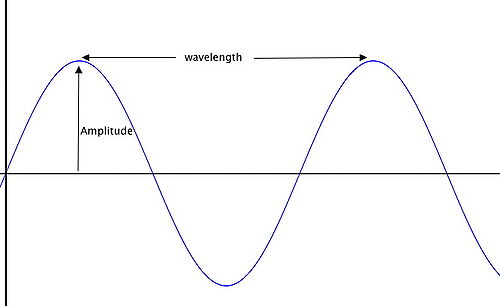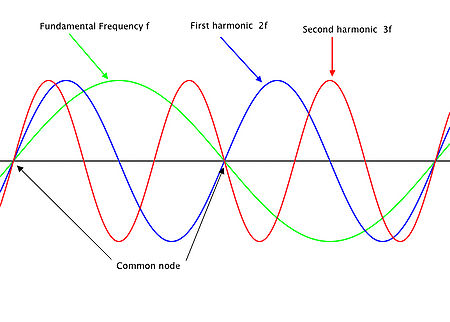Frequency Wavelength and Period
Related wiki pages : Modes, Propagation, Bands, Harmonics
What is a cyclic curve?
Frequency, Wavelength and Period refer to cyclic (repeating) waveforms. In ham radio we usually deal with sinusoidal (shaped like a sine curve), but many other repeating wave shapes are possible.
Mathematically, the basic wave equation is:
<math> \mathit{v}=\mathit{f}\times \lambda </math>
v is the velocity of the wave in metres per second - a constant close to the speed of light for radio waves in the atmosphere.
f is the frequency of the wave - how many cycles pass a fixed point per second
<math> \lambda </math> is the wavelength of the wave in metres - the distance between two peaks of the wave.
So, as the frequency increases, the wavelength decreases - a doubling of frequency causes a halving of wavelength etc.
Wavelength
As indicated in the diagram above, the wavelength of a cyclic curve is the distance between adjacent corresponding points - peak to peak, trough to trough etc. For most ham radio applications, wavelength is measured in metres (m), centimetres (cm) or millimetres (mm). This is in fact how the amateur bands are described - eg 20m, 70cm etc.
Frequency
Frequency is the number of corresponding wave points (eg peaks) that pass a stationary point each second. The unit for this is Hertz (HZ) or cycles per second.
- 1 KHz (Kilohertz) = 1000 Hz
- 1 MHz (Megahertz) = 1 000 000 Hz
- 1 GHz (Gigahertz) = 1 000 000 000 Hz
Period
Period is the time taken for one complete cycle to pass a stationary point.
Period and Frequency
Radiowaves are usually described by their frequency (or by their wavelength when identifying an amateur band) rather than their period. The relationship between period and frequency is that they are ther reciprocal of each other:
<math> T = \frac {1}{f} </math> and
<math> f = \frac {1}{T} </math> where
f = frequency in Hertz (Hz) and
T = the period in seconds
some comparisons between period and frequency are shown below.
| Frequency | 1 mHz (10-3) | 1 Hz (100) | 1 kHz (103) | 1 MHz (106) | 1 GHz (109) | 1 THz (1012) |
|---|---|---|---|---|---|---|
| Period (time) | 1 ks (103) | 1 s (100) | 1 ms (10-3) | 1 µs (10-6) | 1 ns (10-9) | 1 ps (10-12) |
What are Harmonics?
An harmonic of a particular frequency (the fundamental frequency f) is another frequency that is an integer multiple of the first one. For example:
if f = 125MHz, the harmonics would be: 2f = 250MHz, 3f = 375MHz, 4f = 500MHz ..... etc
In the diagram below it can be seen that harmonics share common nodes.
| Propagation and radio wave theory | |
| Propagation | Aurora * E-Skip * IPS * Lightning scatter * Meteor scatter * Satellites * Trans-Equatorial Propagation * Tropospheric ducting |
| Interference | QRM * QRN |
| Theory | Electromagnetic Waves * Frequency Wavelength and Period |

